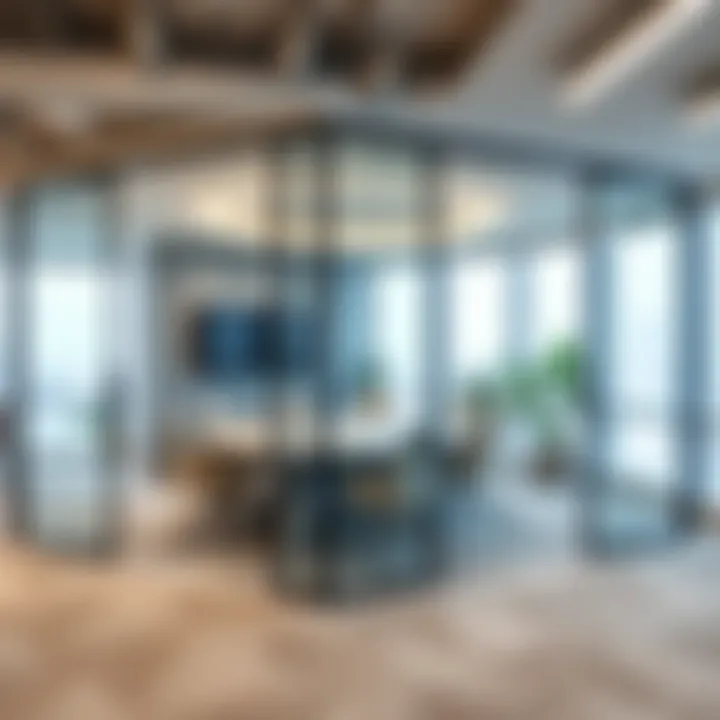Exploring Room Partitioning Strategies in Business Bay


Intro
In the bustling heart of Dubai, Business Bay stands as a symbol of a thriving commercial environment. With its towering skyscrapers and rapidly changing skyline, this district has become a sought-after location for businesses looking to establish themselves in a dynamic market. One of the notable ways in which businesses can optimize their presence in such a competitive space is through effective room partitioning. Understanding the nuances of this practice is crucial for business owners, expats, and investors looking to maximize efficiency while establishing an identity in the market.
The process of partitioning rooms isn’t just about creating walls; it's about shaping workspaces that foster productivity and communication while adhering to local regulations. This article strives to provide a comprehensive overview of various partitioning options available. It dives into market trends, investment strategies, and how these factors collectively play a role in the real estate landscape of Business Bay.
With a keen eye for detail, this narrative aims to equip you—whether an investor, agent, or renter—with the insights needed to navigate this intricate realm of space division. By dissecting current trends and future projections, we uncover not only how to partition spaces but also how to do so in a way that optimizes both functionality and aesthetics.
Understanding the Concept of Room Partitioning
Room partitioning is more than just a practical solution for delineating space; it’s an art form that plays a crucial role in how businesses function in bustling environments like Business Bay. With a landscape that’s always on the go, understanding room partitioning enhances efficiency and caters to a diverse range of user needs. The relevance of this concept is underscored by its ability to cater to the evolving demands of modern workplaces.
Defining Room Partitioning
Room partitioning refers to the practice of dividing larger spaces into smaller, functional ones. This can be achieved through various methods such as adding walls, screens, or movable panels. Each partitioning method serves distinct purposes, which can go from simply creating private offices to more complex designs that separate workflow areas, meeting rooms, or collaborative spaces. For instance, using glass partitions can provide privacy without sacrificing light or visibility, which is vital in a city that thrives on openness and transparency.
The choice of a specific partitioning solution is influenced by several factors including desired aesthetics, functionality, and even building regulations. Property owners often seek a balance between creating a professional presence and ensuring that the workspace remains adaptable to future changes. With Business Bay’s continuous growth, the significance of room partitioning stands at the forefront of strategic space management, making it essential for investors and renters to choose wisely.
The Importance of Space Management
Effective space management is critical for maximizing the potential of any commercial property. In a dynamic environment like Business Bay, where real estate is both an asset and a liability, understanding how to utilize room partitioning effectively can lead to increased productivity and satisfaction among employees and clients alike.
The benefits of well-planned space management include but are not limited to:
- Increased Efficiency: By neatly organizing spaces, businesses can streamline their operations. A good layout fosters collaboration while providing private areas for sensitive discussions.
- Flexibility: Movable partitions offer adaptability which caters to changing business needs. As companies expand or evolve, so too can their workspace with the right partitioning solutions.
- Enhancing Professional Identity: A thoughtfully designed environment speaks volumes about a company’s brand. Successful partitioning helps maintain a professional atmosphere that aligns with corporate values.
"Properly managed spaces not only reflect a business’s competence but also significantly impact employee morale and productivity."
At the end of the day, effective room partitioning and space management are rooted in a deep understanding of the dynamic interplay between design, functionality, and user experience. As the commercial landscape in Business Bay continues to roar ahead, the ability to adapt spaces to fit the needs of businesses becomes even more paramount.
Overview of Business Bay
Business Bay stands as a vibrant epitome of Dubai's unwavering progress, functioning not merely as a commercial hub but as a melting pot of innovation and opportunity. Understanding this locale's distinct characteristics is vital for stakeholders looking to navigate the real estate waters effectively. This section delves into the geographical, economic, and real estate elements of Business Bay. Each plays a crucial role in shaping how spaces, particularly office environments, are partitioned and utilized.
Geographical Context
Nestled in the heart of Dubai, Business Bay boasts an impressive geographical landscape that contributes significantly to its allure. Bordered by the iconic Dubai Canal to the west and set against the backdrop of the Burj Khalifa, the area's geography is more than just eye candy; it enhances accessibility and connectivity. Major roads and transport links weave through and around the district, making it easy for both locals and expatriates to find their way.
The proximity to Dubai Downtown and several key tourist attractions further drives foot traffic, making it an attractive location for businesses ranging from startups to multinational corporations. Its strategic position invites opportunities for creative spatial designs, allowing for innovative room partitioning solutions that leverage visibility, accessibility, and a sense of community.
Economic Significance
The economic framework of Business Bay can be likened to the sharpened edge of a well-honed knife—precise and impactful. The district serves as a business incubator that attracts hefty investments, positioning itself at the crux of Dubai's economic activities. The blend of residential, commercial, and retail spaces fosters a 24/7 vibrant life, where work and leisure intermingle seamlessly.
The local government has emphasized horizontal and vertical development through initiatives that encourage diverse business practices. This eco-system, combining large corporations and smaller entities, intensifies competition and innovation within the market. Augmented by various free zones and business-friendly policies, this environment presents a case for efficient space management—understanding how to design and utilize room spaces can enhance functionality while catering to the economic activities prevalent in this bustling locale.
Real Estate Landscape
The real estate landscape in Business Bay is as dynamic as the businesses it harbors. Boasting skyscrapers with modern amenities, the area has attracted substantial interest from investors, both local and international. This diversity in property types—ranging from luxurious high-rises to functional office spaces—allows for various partitioning solutions tailored to different business needs.
Rising demand for office spaces has necessitated a shift towards innovative designs that emphasize flexibility and adaptability. Companies are now prioritizing spaces that can evolve with their changing requirements. Many developers are now blending cutting-edge architectural designs with practical partitioning systems to enhance privacy and facilitate collaboration.
In summary, grasping the essence of Business Bay regarding its geographical benefits, economic dynamics, and real estate variety is critical. This understanding not only informs current partitioning strategies but also anticipates future trends, making it an indispensable cog in the wheel of successful business operations in Dubai.
Types of Partitioning Solutions
When it comes to partitioning spaces in an office environment, understanding the different types of partitioning solutions available is critical. Each type serves unique purposes, catering to varying needs—from constructing offices to enhancing aesthetics—all while creating an efficient working atmosphere. The suitable choice can have profound implications not just on the physical space, but on collaboration, privacy, and overall productivity as well.
Fixed Partitions
Fixed partitions are perhaps the most traditional approach to dividing space. These are solid walls that are constructed to stand the test of time, offering a durable and lasting solution to room division. They can be made from various materials, including drywall, brick, or concrete. Fixed partitions are often seen as the backbone of office design due to their stability and permanence.
One of the crucial advantages they bring is enhanced sound insulation, a feature that can be a game-changer in open-plan offices where noise can disrupt workflows. Moreover, their ability to create private spaces can promote confidentiality during meetings or phone calls, which is especially relevant in sectors like finance or legal services.


However, choosing fixed partitions does involve commitment. They typically require more substantial investment for both installation and possible future renovations. Changes to office layout become a daunting task, often demanding significant time and resources. So, for businesses aiming for flexibility, this option might not be the most appealing.
Movable Partitions
On the other hand, movable partitions offer a level of adaptability that fixed options cannot match. These partitions can be installed and removed as needed, allowing for quick changes to office configurations. Commonly made from lightweight materials such as fabric, wood, or even metal frames, they give businesses the flexibility to respond quickly to changing needs, especially in dynamic environments like coworking spaces.
Benefits include:*
- Flexibility: Easily create large open areas or cubicles depending on daily requirements.
- Cost-effective: Generally lower cost compared to construction of fixed walls.
- Reconfigurability: Get to reimagine a workspace layout without the logistical headache of a major renovation.
Yet, while movable partitions provide flexibility, they might fall short in sound insulation compared to their fixed counterparts. Therefore, balancing flexibility with privacy needs is an essential factor when considering this option.
Glass Partitions
The modern office is increasingly embracing glass partitions. These partitions, which can be either fully transparent or frosted for privacy, deliver a sleek, contemporary look that appeals to many design aesthetics. Glass has a unique way of creating an airy sense of openness, which promotes a more collaborative atmosphere, making it a popular choice in workplaces where teamwork and synergy are vital.
One significant benefit of glass partitions is their ability to maximize natural light, fostering a bright environment that may lead to enhanced employee morale. Furthermore, the visual connection they maintain between spaces can encourage communication across departmental lines.
However, glass partitions do pose challenges. The need for privacy can be compelling for certain businesses, and clear glass can compromise that. They also require regular cleaning to maintain their aesthetic appeal, which could entail additional operational costs. Thus, striking a balance between openness and privacy is crucial when integrating glass elements.
Acoustic Partitions
As the name suggests, acoustic partitions focus on sound management. These walls are specifically designed to absorb sound, making them a valuable addition to open office environments or multifunctional spaces. Businesses that prioritize confidentiality, such as call centers or therapy clinics, will find acoustic partitions particularly beneficial by preventing sensitive conversations from traveling across the office.
Key highlights include:
- Sound Absorption: Excellent control over noise levels, enhancing concentration and reducing distractions.
- Customizable Designs: Available in various designs and materials, making them versatile in style.
- Improved Productivity: A quieter workspace can lead to higher focus and better overall performance.
However, the cost can be considerably higher than standard partitions, which may lead to budgetary concerns. Additionally, while they help mitigate sound, they may not offer the solid privacy that some businesses require, potentially making them less effective in settings where private discussions occur regularly.
Ultimately, understanding the differing characteristics of these partition types will aid stakeholders in making decisions suited to their operational and aesthetic needs in Business Bay's competitive environment. Choosing the right partitioning solution not only optimizes space but also enriches the working experience, reinforcing the office's identity and functionality.
Benefits of Partitioning Rooms
In today’s fast-paced business environment, especially in a bustling area like Business Bay, the arrangement and division of spaces can significantly influence operational efficiency. Room partitioning offers a multitude of benefits that cater not just to operational needs, but also to a company's cultural and aesthetic values. Taking into account what partitioning can bring to the table, we can break down its advantages into three pivotal aspects: enhanced privacy, optimized workflow, and cost-effectiveness.
Enhanced Privacy
In a workspace, privacy often becomes a luxury rather than a necessity. When businesses employ room partitioning, they create distinct areas that allow for confidential meetings and discussions—the kind where sensitive information is exchanged without concern for prying ears. Walls or partitions reinforce the notion of privacy, thereby fostering trust and comfort among employees.
"Creating enclosed spaces significantly reduces sound pollution and minimizes distractions, leading to a more peaceful working atmosphere, which can enhance focus."
For instance, consider a law firm or an HR department dealing with confidential files. By employing glass or acoustic partitions, they can maintain a professional facade while ensuring that conversations are held behind a shield of privacy. The sense of security in such environments encourages open dialogue and collaboration, ultimately leading to more innovative ideas and solutions.
Optimized Workflow
Another vital benefit is the optimization of workflow. Partitioning does not just create barriers; it facilitates organization. By segmenting spaces, employees can better manage their time and tasks. For businesses that thrive on collaborative efforts, movable partitions can be a game-changer. This flexibility allows teams to adapt their environments according to project needs or team sizes, promoting adaptability.
Think about an architecture firm where teams may need to brainstorm ideas or present designs at any moment. Adjustable partitions can convert an open floor into a multi-functional space, easily toggling between collaborative zones and solitary areas for concentration. It’s all about adjusting the work environment to capture the team’s rhythm.
Cost-Effectiveness
Implementing room partitioning can often result in lower operational costs over time. Instead of moving to a larger space to accommodate growing teams, companies can efficiently use existing square footage. Instead of committing to long-term leases for larger properties, businesses can invest in partitions that allow for maximum utilization of their current spaces.
Moreover, these flexible setups can lead to savings on services like cleaning and maintenance, as focused areas mean less square footage to manage. It's a win-win situation: keeping costs low while fostering a productive atmosphere. As more companies are recognizing the need for flexible space utilization, the trend towards responsible budgeting in Business Bay is likely to continue growing.
Space Optimization Techniques
When considering the layout of any workspace, particularly in a bustling business hub like Business Bay, it's vital to focus on space optimization techniques. Optimizing space involves more than just physical arrangement; it also encompasses strategic planning that promotes functionality and versatility. Having a strong grasp of these techniques can propel a business to new heights, ensuring that every square foot is utilized effectively.
Space optimization is crucial in densely packed environments where every inch matters. A well-optimized space translates to improved employee satisfaction, greater productivity, and potentially lower operational costs. Companies that invest time in understanding their spatial needs can create environments that not only elevate their brand image but also support their operational goals.
Assessing Space Needs
The first step in space optimization is assessing your actual space needs. This requires a thorough analysis of both current and future requirements. Key questions to consider include:


- How many employees will be in the space at any given time?
- Will you need dedicated areas for meetings, collaboration, or quiet work?
- What types of equipment or technology will require space?
Understanding these elements can help in establishing whether to create open spaces or individual offices. This groundwork is significant; it enables businesses to make informed decisions regarding their design and layout.
One of the common pitfalls here is underestimating future growth. Depending solely on current space might lead to costly renovations soon after setup. Thus, keeping scalability in mind is critical. Investors should consider the types of partitions best suited to not only today’s needs but also tomorrow’s potential changes.
Designing Flexible Workspaces
Once the space needs are assessed, the next step is to design flexible workspaces. Flexibility means creating environments that can easily adapt to changes—perhaps resizing for a team expansion or creating a temporary meeting area. The design can include movable walls or modular furniture that can be rearranged as needed.
The beauty of flexible workspaces lies in their adaptability. Modern businesses are often rejigging team structures or project demands. A well-planned flexible workspace can accommodate these shifts without incurring substantial additional costs. Recommendations for creating flexibility could be:
- Utilization of movable partitions to create dynamic layouts.
- Investing in versatile furniture, like foldable desks or chairs, to optimize storage and movement.
- Establishing dedicated areas for collaboration that can be closed off or opened up as required.
Integrating Technology
In today’s digital age, integrating technology is key for optimizing space. Advanced technology enables not only efficient operation but also enhances the utilization of the physical workspace. Smart building technologies can control lighting, temperature, and even space-finding tools that allow workers to find available desks or meeting rooms quickly.
Several methods to integrate technology in space optimization may include:
- Virtual reality to visualize the impacts of different partition setups before implementation.
- Using cloud-based applications for real-time management of space usage, helping businesses adapt usage based on actual needs.
- IoT devices to monitor occupancy and optimize layout accordingly, ensuring that every inch of available space is maximized.
By strategically applying these techniques, businesses in Business Bay can ensure not only the immediate effectiveness of their layout but also create a foundation for future growth and adaptability. It's about finding that sweet spot where functionality meets aesthetic appeal.
Legal Considerations in Partitioning
When it comes to partitioning spaces in Business Bay, understanding the legal landscape is critical. It's not just about aesthetics and functionality; there are rules and regulations that govern space division. Ignoring these can lead to costly consequences, and potentially halt progress on a project. Therefore, being mindful of legal considerations ensures that businesses can operate smoothly while adhering to established norms.
Building Regulations
In Dubai, building regulations are enforced by local authorities to maintain safety standards and ensure structural integrity. These rules cover a wide array of topics, from the materials used in partitions to the overall structural design. It's vital for business owners to familiarize themselves with the specific regulations that apply to their premises. Here are a few essential points:
- Permitting Processes: Securing the necessary permits before commencement of the partitioning work helps prevent legal disputes.
- Local Codes: Regulations differ from one free zone to another. Those operating in Business Bay must ensure they are in line with the Dubai Building Code.
- Fire Safety: Safety measures must be put in place, particularly when it comes to fire-rated partitions that can contain flames and smoke.
There's a wealth of information available on official sites like Dubai's Department of Economic Development, which can guide businesses effectively on compliance matters.
Lease Agreements Review
Before making any changes to a rented space, reviewing the lease agreement is crucial. Often, leases have stipulations regarding alterations or modifications to the property. Failure to comply can lead to breaches of contract, resulting in financial penalties or even eviction. Points to consider include:
- Alteration Clauses: Some leases may explicitly prohibit any structural changes without the landlord's approval.
- Restoration Requirement: In some cases, business occupants must restore the original condition of the space upon lease termination. This underlines the importance of considering reversible partitioning options.
- Shared Spaces: If the space is part of a multi-tenant building, understanding shared space rules is vital, particularly regarding noise and privacy concerns.
Consulting a real estate lawyer can help clarify any ambiguous terms in lease agreements, ensuring you're not caught off guard.
Compliance and Safety Standards
Compliance with safety standards is not just a legal obligation, but also a commitment to the well-being of employees and visitors. Partitioning solutions must meet the General Authority for Islamic Affairs and Endowments and Civil Defense standards. Key considerations include:
- Accessibility: Ensuring that partitions do not impede accessibility for individuals with disabilities.
- Material Safety: Selecting partition materials that are compliant with health codes to avoid toxic emissions and ensure indoor air quality.
- Maintenance: Regular inspections and maintenance of partition systems ensure they remain safe and functional over time.
Cost Implications of Room Partitioning
Understanding the financial impact of partitioning rooms is crucial for anyone considering changes to their workspace in Business Bay. Not only does it involve initial costs, but there are also ongoing expenses to consider. The right financial planning can mean the difference between a well-executed space transformation and facing unexpected budgetary constraints.
Budgeting for Installation
Installation costs can vary widely depending on the type of partition chosen. For instance, fixed partitions, while robust, require a higher upfront investment due to labor and materials. Movable partitions, on the other hand, may be more economical at first glance but can involve additional costs over time due to maintenance and potential replacement.
Here are some key factors to consider when budgeting for installation:
- Material Costs: Prices fluctuate based on the material selected, such as drywall, glass, or wooden panels. Glass partitions might offer a chic look but often come at a premium.
- Labor Charges: Hiring skilled professionals is essential. This includes carpenters and installers specialized in the type of construction you choose. Remember, a good job up front can save you headaches down the line.
- Time Consideration: Installation time impacts your overall budget too. The longer it takes, the more you may end up spending on temporary solutions, like renting additional space or facilities during the process.
To make it easier, businesses should create a detailed breakdown of anticipated costs to maintain clarity in budget allocation.


Recurrent Costs Post-Installation
Once the partitions are installed, the fiscal responsibility doesn’t stop there. Understanding recurrent costs post-installation is key to maintaining financial viability. These can include:
- Maintenance Expenses: Depending on the material, some partitions require more upkeep. For example, glass partitions need regular cleaning to keep them looking pristine, which translates to ongoing cleaning expenses.
- Utility Costs: If partitions are not soundproofed or insulated properly, there may be increased heating or cooling expenses. This is particularly significant in Business Bay, where climate control is vital.
- Flexibility Costs: For movable partitions, consider how often you will rearrange the space. If changes are frequent, factor in potential reconfiguration costs and associated labor.
"Properly accounting for installation and recurrent costs can bolster long-term profitability and efficiency in workspace management."
Trends in Business Bay Real Estate
When you take a stroll through Business Bay nowadays, the air is thick with innovation and evolving dynamics. Recognizing these trends in real estate is crucial for anyone looking to invest or establish themselves in this busy locale. Understanding the latest patterns not only enriches the decision-making process but can also lead to substantial benefits, from enhanced property value to ensuring smoother operations.
Emerging Market Patterns
Business Bay is witnessing a kaleidoscope of market patterns, driven by both local demand and global influences. Here are a few key elements shaping the current landscape:
- High Demand for Mixed-Use Developments: Investors are increasingly leaning towards properties that blend residential, commercial, and leisure spaces. This mix appeals to both renters and buyers who favor convenience.
- Luxury Segment Growth: There’s a surge in high-end commercial spaces, reflecting a market willing to invest in premium quality. Properties designed with modern aesthetics and amenities are fetching higher prices.
- Rental Market Dynamics: The rental market is also shifting, with many businesses adapting to the evolving needs of their workforce by seeking flexible leasing options to accommodate fluctuating team sizes.
With the rapid evolution of these patterns, staying tuned in to market movements is key. It’s a dance where timing could mean the difference between profit and loss.
Sustainable Development Focus
In an era where environmental concerns are on everybody's lips, Business Bay is putting its best foot forward with sustainable development practices. Let’s break it down:
- Integration of Green Features: New buildings are incorporating solar panels, energy-efficient systems, and eco-friendly materials. This not only reduces operational costs but also attracts a more environmentally conscious clientele.
- Community-Centric Designs: Developers are moving beyond just the building; they’re creating spaces that foster community interaction. Parks and shared working areas add charm and functionality, enhancing the live-work-play atmosphere.
- Government Incentives: Thanks to government initiatives promoting sustainability, developing green buildings can come with incentives that ease some of the financial burdens for developers.
The push towards sustainable practices is not just a trend; it’s a necessity that businesses in Business Bay must embrace.
Shift Towards Hybrid Work Environments
The global pandemic has nudged businesses into adjusting their operational frameworks, with hybrid work setups gaining traction. The implications for room partitioning and space management in Business Bay are significant:
- Flexible Workspaces are a Must: Companies are increasingly looking for spaces that offer the ability to quickly adapt. Movable partitions, for instance, can create privacy when needed, but also allow for open collaboration.
- Focus on Employee Wellness: As work environments evolve, so does the need for areas dedicated to mental health and well-being. Designs that consider natural light and ventilation are becoming essential in meeting new employee expectations.
- Office Redesign and Reuse: An interesting angle is companies choosing to redesign existing spaces rather than moving. This not only saves costs but can also result in unique hybrid environments tailored to specific needs.
This evolution in work structure is a testament to the adaptability of businesses in Business Bay, and it undoubtedly shapes the real estate market in profound ways.
Choosing the Right Partition System
Selecting the appropriate partition system for spaces in Business Bay can be a make-or-break decision for businesses aiming to cultivate a professional ambiance. The right choice does more than just physically separate areas; it embodies the ethos of a company, enhances privacy, and encourages productivity. The importance of choosing wisely cannot be overstated, as in an ever-evolving business locale like Business Bay, a well-thought-out partition system can represent future growth and flexibility. That's crucial when different operational needs and zoning laws come into play.
Factors to Consider
When it comes to partitioning choices, several relevant factors must be taken into account:
- Purpose of Space: First thing's first, define what each space is meant for. Is it collaborative work or quiet focus? Different zones necessitate different partitioning solutions.
- Flexibility: If adaptability is a top priority, movable partitions would be a suitable choice. They allow adjustment as business requirements change, saving the hassle and cost of complete renovations.
- Aesthetic Appeal: The look and feel of the partition can greatly influence the company’s image. Glass partitions, for instance, project openness, while solid walls might convey sturdiness. Choose wisely to align with your brand's identity.
- Acoustic Properties: For entities where focus is key, soundproofing becomes essential. This is particularly true for legal firms or consultancies reliant on confidentiality.
- Budget: It's prudent to balance between options available. Clear costs associated with different systems often help in making informed choices.
Exploring the factors above allows business owners to make a systematic analysis of what is needed in a partition system. Taking the time to evaluate these elements can lead to a more effective space design.
Consulting a Professional
In the intricate landscape of businesses within Business Bay, consulting an expert in partition systems may prove invaluable. An experienced professional can assist in several ways:
- Design Insights: They can propose designs that comply with local regulations while still meeting your aesthetic preferences. Every space is unique; tailored solutions minimize potential issues.
- Material Recommendations: The professionals have access to the latest materials and technology, providing advice on the best options available that fit both the space's use and the budget.
- Installation Expertise: Proper installation is crucial. Mistakes can lead to costly corrections or compromises in the effectiveness of the partition.
- Compliance Guidance: Every installation needs to adhere to building codes and safety regulations. A professional ensures these aspects are accounted for, alleviating potential legal worries down the line.
Overall, navigating the many choices available in Business Bay requires both patience and expertise. Not only does a qualified consultant provide peace of mind, but they also contribute significantly to enhancing the utility and aesthetic of the space.
"A well-designed space can speak volumes about a business, influencing clients' perceptions before even a word is said."
In sum, choosing the right partition system involves a careful examination of factors relevant to your specific environment, alongside the insight from professionals who understand the intricacies of local regulations and design possibilities.
Closure
The topic of room partitioning is essential in the context of Business Bay, where space is often at a premium yet critical for efficiency. Understanding the intricate details surrounding partition options allows businesses and individuals to leverage architectural flexibility, ensuring their work environment supports both functionality and aesthetic appeal.
Summarizing Key Insights
Effective room partitioning serves various needs—from enhancing privacy to streamlining workflows. Key insights captured throughout this article underscore how thoughtful space management can transform a conventional office setup into a vibrant hub of productivity. For instance, movable partitions are particularly advantageous for companies that require adaptable workspaces that can shift according to the immediate demands of projects or team sizes.
Furthermore, discussing the legal considerations—such as compliance with building regulations—shows the importance of maintaining not just a functional space but also a legally sound environment. In essence, investing in the right partition systems yields long-term benefits and aligns with the overarching trend of optimizing workspaces in urban settings like Business Bay.
Future Outlook for Room Partitioning in Business Bay
Looking ahead, the evolution of room partitioning trends illustrates a movement towards more sustainable, practical solutions. As Business Bay continues to flourish, the demand for innovative partition systems is likely to escalate. This reflects broader shifts in work culture towards flexibility and collaboration brought on by technological advancements and changing workforce dynamics.
The future may see an increase in eco-friendly materials and multifunctional designs that cater to the hybrid work model. This adaptation not only meets the needs of modern-day operations but also speaks volumes about the commitment to sustainability within the design of commercial spaces.

